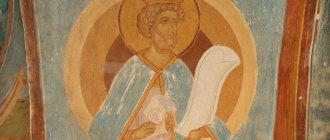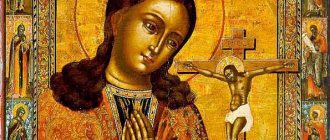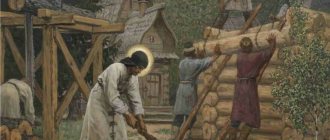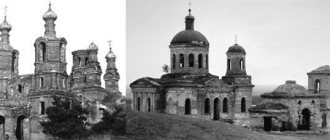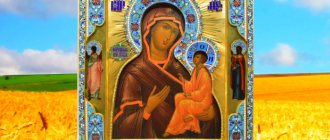Only a small part of Christian ascetics are awarded the title of Equal-to-the-Apostles. As a rule, we are talking about those saints who appeared on earth after the life of Christ himself in the body, that is, they could not be appointed as apostles by the Savior himself. Nevertheless, the feat of these people was incredibly significant for the church, so they were awarded the title of equal to the apostles, that is, equal to the apostles themselves.
The icon of Helena, Queen of Constantinople, considered here, also belongs to these saints. It was under her that Christianity ceased to be persecuted and became an allowed religion on the territory of the Roman Empire.
Prayers to the saints
Memory: March 6 / March 19, May 21 / June 1
Queen Equal to the Apostles Helen of Constantinople is the mother of Tsar Constantine.
The first merit of Queen Helena was that she endeared her son Constantine to the Christian faith, and through this gradually the entire Roman world became Christian. The second merit of Queen Helena is the erection of the Holy Cross and the construction of now famous and iconic churches in the Holy Land. Through her efforts, the Church of the Resurrection (and the Holy Sepulcher) was built on Calvary, where the Holy Fire descends annually on Easter night; on the Mount of Olives (where the Lord ascended to Heaven); in Bethlehem (where the Lord was born according to the flesh) and in Hebron at the Oak of Mamre (where God appeared to Abraham). Saint Helena is the patroness of the church clergy, temple builders, philanthropists and missionaries. They pray to her for the gift and strengthening of faith in children and relatives, for the gift of parental zeal for raising children in the faith, for the admonition of non-believers and sectarians. She is prayerfully commemorated together with her Equal-to-the-Apostles son Constantine. Equal to the Apostles Tsar Constantine and Queen Helen of Constantinople. Icon
Troparion to the Equal-to-the-Apostles Tsar Constantine and Queen Helena, tone 8
Having seen the image of Thy Cross in Heaven and, like Paul, the title is not received from man, Thy apostle has become a king, O Lord, put the reigning city in Thy hand, which you always save in the world through the prayers of the Mother of God, who alone loves mankind.
Kontakion of Equal-to-the-Apostles Tsar Constantine and Queen Helena, tone 3
Constantine today with the Mother Helena the Cross is revealed, an all-honorable tree, a shame for all Jews, and a weapon against faithful people: for for our sake a great sign has appeared and a terrible sign in battle.
First prayer to Equal-to-the-Apostles Tsar Constantine and Queen Helena
About the wonderful and all-praised king, the holy Equal-to-the-Apostles Constantine and Helen! To you, as a warm intercessor, we offer our unworthy prayers, for you have great boldness towards the Lord. Ask Him for peace for the Church and prosperity for the whole world. Wisdom for the ruler, care for the flock for the shepherd, humility for the flock, desired repose for the elder, strength for the husband, beauty for the wife, purity for the virgin, obedience for the child, Christian education for the baby, healing for the sick, reconciliation for the offended, patience for the offended, fear of God for the offended. To those who come to this temple and pray in it, a holy blessing and everything useful for each request, let us praise and sing the Benefactor of all God in the Trinity of the glorified Father and the Son and the Holy Spirit, now and ever, and unto the ages of ages. Amen.
Second prayer to Equal-to-the-Apostles Tsar Constantine and Queen Helena
About Saints Equal-to-the-Apostles Constantine and Helen! Deliver this parish and our temple from every slander of the enemy, and do not forsake us, the weak, through your intercession ( names
), beg the goodness of Christ our God to grant us peace of mind, abstinence from destructive passions and all filth, and unfeigned piety. Ask us, pleasers of God, from above for the spirit of meekness and humility, the spirit of patience and repentance, so that we may live the rest of our life in faith and contrition of heart, and so at the hour of our death we will gratefully praise the Lord who glorified you, the Father Without Beginning, His Only Begotten Son and the Consubstantial All-Blessed One. Spirit, the Indivisible Trinity, forever and ever. Amen.
Read other prayers in the “Orthodox Prayer Book” section
Missionary and apologetic project “Towards Truth”, 2004 – 2017
When using our original materials, please provide the link:
Troparion, tone 8*
Audio:
Having seen the image of Your Cross in Heaven/ and, like Paul, the title is not received from man,/ Your apostle is in the kingdom, O Lord,/ Place the reigning city in Your hands,/ save it always in the world through the prayers of the Mother of God, // One who loves mankind.
Translation: Having seen the image of Your Cross in heaven, and, like Paul, having heard the call not from people, among kings - Your Apostle, Lord, entrusted the reigning city into Your hand; and always preserve it in peace, through the intercessions of the Mother of God, O One Lover of Mankind.
What does the icon of St. Helena help with?
The icon of St. Helena is the greatest relic in the history of Orthodoxy. She is a part of the past that came to the future in order to remain in it for centuries, turning into one of the most revered images. It contains the soul of the people, their pain and suffering, difficult periods of formation and faith, which, having gone through a long and difficult path, has become a symbol of all Christianity.
Icon of Helen Equal to the Apostles
The mother of the Roman Emperor Constantine, Helen, like himself, can be called the most outstanding personalities in the history of Orthodoxy of all centuries who were canonized as equal to the apostles.
They have long been depicted on icons as people who contributed to the strengthening of Christianity. Elena helped faithful Christians return their relics and shrines, and helped in the construction of temples and churches. But most of all, she became famous for her righteous deeds in the name of Christ. And the main one is the Exaltation of the Holy Cross.
Icon of Saint Helena, meaning, what it helps with
The true meaning of this face is that every believer who turns to him not only finds help and salvation, but also strengthens his faith, just as Elena did. The holy image teaches that everyone who believes in the Lord must sacredly carry out his work and honor him.
On the face, Elena is depicted with her son Constantine, where each of them supports the Cross with one hand. This is a symbol of support and assistance in the revival of Christianity and a sign that it will always exist as long as there are people who, through their faith and righteous deeds, carry it in their hearts, as they carry the word of God, and it is eternal on earth.
What does the Icon of St. Helena help with?
Along with many Orthodox icons, the face has enormous miraculous power and is distinguished by the fact that the people depicted on it gained holiness and became revered among people, thanks to their thoughts and deeds, which means they had a high spiritual culture, which had no equal. This is a great Christian example of how a righteous deed in the name of the Almighty becomes the road to eternal life, for faith for a person is everything: his strength, love, fidelity and repentance.
Thousands of Christians still come to the icon today in order to raise their prayers to ask for help and gain strength for struggle and development. The face helps in such matters and life situations:
improvement of material well-being; the beginning of a new important business; promotion, career; success in the political arena.
In addition, the image is the sacred patron of the family and everything connected with it. That is why people often turn to him with prayers for preserving the family home, raising children (even about their birth - infertility treatment), resolving conflicts, reviving understanding, trust, and love.
The image is also very revered among agricultural workers and ordinary Christians working on the land. It is believed to help increase harvest and fertility, which in turn will bring prosperity to all who have worked for the good.
We advise you to study the Prayer of Thanks to Spyridon of Trimifuntsky for his help
Its great help is in healing ailments and strengthening physical health, which is inextricably linked with the spiritual, for a person who wants to heal the body must start with the soul. And here the main thing is faith, eternal and unshakable. Only she is the only true road to God's grace.
They turn to the Saint for protection with these words:
About the wonderful and all-praised king, the holy Equal-to-the-Apostles Constantine and Helen! To you, as a warm intercessor, we offer our unworthy prayers, for you have great boldness towards the Lord. Ask Him for the peace of the Church and prosperity for the whole world, wisdom for the ruler, care for the flock for the shepherd, humility for the flock, desired peace for the elders, strength for husbands, beauty for women, purity for virgins, obedience for children, Christian education for babies, healing for the sick, reconciliation for those at war, patience for the offended, those who offend the fear of God. To those who come to this temple and pray in it, a holy blessing and everything useful for each request, let us praise and sing the Benefactor of all God in the Trinity of the glorified Father, and the Son, and the Holy Spirit, now and ever and unto ages of ages. Amen.
The icon of Queen Helen Equal to the Apostles is a true masterpiece of Christianity, the significance of which cannot be exaggerated. She not only helps, saves and gives hope, she teaches everyone a righteous life, for only in a person’s thoughts and deeds does his future lie
It is important to always remember that the faith that the Lord gives must be increased and shared among others; you need to understand that only the right deed, aimed at good and supported by God’s grace, will have the result that every Christian strives for
May the Lord protect you!
You will also be interested in watching a video about the life of St. Helena:
Merits of the queen
Helen was the mother of the Roman Emperor Constantine. These are some of the most outstanding personalities whom the Orthodox Church canonized as equal to the apostles.
- The mother was able to convert her son to Christianity. As a result, he gradually attracted the entire Roman people to this faith.
- The erection of the Honest Cross - Elena and Konstantin were able to find the cross on which Jesus Christ was crucified. The search took a long time, but was crowned with success. Three crosses were found and doubts arose as to which one was the one being sought. But near one there was a miraculous healing of a seriously ill woman and the resurrection of the deceased. After this, the queen brought one part of the shrine to her son, and left the second in Jerusalem. The divine power of Christ remained on him forever. The cross began to be called Life-Giving. Many other miracles happened near him.
- Construction of iconic churches for the Orthodox world: the Resurrection of the Lord on Golgotha; on the Mount of Olives, where the Ascension of the Lord took place; in Bethlehem - the birthplace of the Messiah; in Hebron, where God appeared to Abraham.
Elena also helped believers return relics and shrines to their churches. She became a great Christian example of how to live in the name of the Almighty.
The memory of the Equal-to-the-Apostles Queen is celebrated on March 19 and June 3. Her relics are kept in Paris, where they were transported in the 10th century. Before this, the incorruptible remains were in the mausoleum that her son Konstantin built for himself.
What does it help with?
Few people know what the icon of St. Helena helps with. They ask her for help:
- sick in soul and body;
- those who find it difficult to make a choice;
- people who need to support their faith;
- for the salvation of your soul.
The face, like all Orthodox icons, has miraculous powers. After all, it depicts people who, through their deeds, have earned the title of Equal-to-the-Apostles. And looking at them, we must take an example, not only spiritually, but also in everyday life. Elena was a woman who gave her whole life for her favorite business. So why didn’t it occur to any of us? Why, looking at icons and praying to them, we expect a miracle from the Lord. After all, we ourselves can create, albeit a small, but still a miracle. Looking at the faces of the saints, we must take their example, because that is what they were created for.
It often happened that the icons of St. Helen Equal to the Apostles began to stream myrrh. This myrrh was used for medicinal purposes. They said that it could heal any disease. Therefore, having heard that somewhere the icon of St. Helena has begun to sharpen the world, Christians from all over the planet come to collect the healing substance. Thus, we can say that the face saved more than one hundred lives.
How can prayer help?
The Roman queen is the patroness of the church clergy, the people who build temples and do charity work.
The prayer to Saint Helena Equal to the Apostles helps believers in the following:
- acquire and strengthen faith;
- raise children;
- to bring reason to non-believers and sectarians;
- gain strength to fight and recover;
- make a choice;
- improve financial condition;
- successfully start a new business;
- advance in career;
- get success in your political career.
All who pray before the icon of Helen will find help and salvation. She teaches to carry the Lord's affairs and honor the Most High. The prayer to Saint Helena is used by people whose work is connected with the earth. It helps to get an excellent harvest, which will increase the income of farmers.
The saint also patronizes the family and everything connected with it. They appeal to Elena to maintain peace between the spouses, to revive love, and to gain mutual understanding. There are many reviews about the gift of children after turning to the queen. Her great help is also in matters related to health, both physical and spiritual.
Story
Cyril and Methodius are famous for their preaching of Christianity in Great Moravia, which in the 9th century included modern Czech Republic, Slovakia and Austria.
Ruler Rostislav (later Saint Rostislav), seeking to avoid the influence of the Franco-German Carolingians, turned to Rome for missionaries for Moravia, but Rome refused. Therefore, Rostislav turned instead to the Byzantine Empire, which resulted in the sending of Cyril and Methodius.
With the approval of the Pope, they taught in the Slavic language rather than Latin, which caused considerable friction among the German monks and clergy, who tried to stop preaching and writing in the Slavic language, but without success.
From this it can be seen that at that time religion and politics were very mixed. Moreover, although the two branches of Christianity, Greek and Roman, had not yet split in the Great Schism of 1054, there were nevertheless already signs of discord, to which political interests were added.
The preaching of Cyril and Methodius added a third element to this - Slavic Christianity, which eventually led to the Russian concept of Moscow as the "Third Rome" after the fall of the Byzantine Empire in 1453. After this, Greek Orthodoxy declined as Russian Orthodoxy continued its rise.
In any case, Cyril and Methodius, being saints before the schism, are now highly revered both in Eastern Orthodoxy (especially in its Russian form) and in Roman Catholic Christianity.
Rituals on Helen's Day
Despite the fact that according to custom, men sowed flax on June 3, women also played an important role. In particular, they performed special rituals that were designed to increase harvest and luck.
On the day before Olena-Flax, women gathered in a separate hut and each brought two eggs with them. They were baked in the oven and then placed in bags with flax seeds. This had to be done so that no one would notice, otherwise the evil eye could not be avoided.
In the morning, the men took sacks and went to the field to sow flax. However, before that, each of them threw the eggs as high as possible. If someone succeeded better than anyone, then he could count on the richest harvest.
The shells of these eggs were not thrown away, but were always brought home. It was ground into powder and fed to chickens to help them lay eggs better.
Another ritual, which was held on June 3, was also associated with the sowing of flax. Women went out into the field and completely took off their clothes. They believed that flax would see them naked, take pity on them and give them everything they needed so that they could sew themselves a shirt.
There was even a corresponding saying, which was attributed to flax: “This woman is poor - she doesn’t even have a shirt on her body, you’ll have to take pity on her and do better.”
The innkeeper's young daughter
Who is she, Holy Equal-to-the-Apostles Queen Helen, whose icon is found in most Russian churches and attracts crowds of believers? To answer this question, let us open the life of the holy servant of God, compiled a short time after her blessed death, and the few works of ancient historians that have reached us, describing her glorious deeds.
Around 250, in the Asia Minor city of Bethany, the owner of a local inn had a daughter who helped him serve visitors. This was the future Saint Helen. The icon of this queen equal to the apostles presents us today with the image of a majestic woman, directing her inner gaze to the heavenly world, and in those days she was still a simple girl who did not think about the great mission ahead of her. And, as happened at all times, one day she fell in love.
Other personalized icons of Elena
Let us also note other ascetics with identical names, in particular:
- Elena of Serbia - the icon is dedicated to the mother of two Orthodox rulers: St. Stephen and Dragutin, she led pious activities and helped many people, built shelters, churches and much more.
- Elena Diveevskaya - the icon depicts an Orthodox saint, whom Seraphim of Sarov himself blessed to become a monk, this girl at a young age experienced a vision and rejected secular entertainment, becoming completely pleasing to the Lord, her relics remain incorruptible and still work various miracles and help believers.
Helen's name day according to the church calendar: the martyr Helen and Elpidia are venerated on January 28. However, veneration of these martyrs is not widespread. They are among the numerous ascetics whose memory has been lost through the centuries.
Biography
Fragment of a sculpture of Helen (Capitolian Museum)
The exact year of Elena's birth is unknown. She was born in the town of Drepan in Bithynia (not far from Constantinople in Asia Minor), as Procopius reports. Later, her son, Emperor Constantine the Great, in honor of his mother, “ made the former village of Drepana a city and named it Elenopol.”
"
Today this settlement is identified [ source not specified 349 days
] with the Turkish city of Hersek, outskirts of Altinova, Yalova province.
According to modern historians [ source not specified 349 days
], Elena helped her father at the horse station, poured wine for travelers waiting for the horses to be re-harnessed and repositioned, or simply worked as a maid in a tavern. There she apparently met Constantius Chlorus under Maximian Herculius, who became the ruler (Caesar) of the West. In the early 270s, she became his wife, or concubine, that is, an unofficial permanent cohabitant.
On February 27, 272, in the city of Naiss (modern Serbian Niš), Helen gave birth to a son, Flavius Valerius Aurelius Constantine, the future Emperor Constantine the Great, who made Christianity the state religion of the Roman Empire. Nothing is known about whether Elena had any more children [ source not specified 349 days
].
We advise you to study Prayers to Arseny the Great
Foll (copper coin) with a portrait of Helen. Trier coinage ca. 326 years
In 293, Constantius was adopted by Emperor Maximian and separated from Helen, marrying Maximian's stepdaughter Theodora. After this and before the reign of her son, there is no information about Elena’s life. Probably [ source not specified 349 days
], she did not move far from her native places, since her son Constantine began his rise from Nicomedia (the center of Bithynia), from where he was called to the west in 305 by his father, who became emperor of the western part of the Roman Empire.
It is possible [ source not specified 349 days
] that Helen moved west closer to her son in Trevir (modern Trier), which became the residence of Constantine after he inherited the westernmost part of the Roman Empire from his father.
A pamphlet published by the episcopate and clergy of Trier Cathedral reports that St. Helena " gave part of her palace to Bishop Agritius
" for the use of a church, becoming the founder of the Trier Cathedral of St. Peter.
When Elena converted to Christianity, she was already over sixty. According to the testimony of her contemporary Eusebius of Caesarea, this happened under the influence of her son Constantine. The first coins with the image of Helen, where she is titled Nobilissima Femina
(lit. “most noble woman”), were minted in - gg. in Thessalonica. During this period, Helen probably lived at the imperial court in Rome or Trier, but there is no mention of this in historical chronicles. In Rome she owned a vast estate near the Lateran. In one of the premises of her palace, a Christian church was built - the Helena Basilica (Liber Pontificalis attributes its construction to Constantine, but historians do not exclude the possibility that the idea of rebuilding the palace belonged to Helena herself).
In 324, Helen was proclaimed Augusta
: “
He crowned his godly mother, Helen, with a royal crown, and allowed her, as a queen, to mint her own coin
.”
Eusebius noted that Constantine entrusted Helen with managing the royal treasury at her discretion [ source not specified 349 days
].
There is also evidence of the emperor’s great respect for his mother from a non-Christian historian. Aurelius Victor tells the story of how Constantine killed his wife Fausta because of Helen's reproaches against her.
«Saint Helen's Journey to Jerusalem
"(Altobello Melone, first half of the 16th century)
In 326, Elena (already at a very old age, although in good health) undertook a pilgrimage to Jerusalem: “ this old woman of extraordinary intelligence, with the speed of a youth, hurried to the east
" Eusebius spoke in detail about her pious activities during the journey, and echoes of it were preserved in the 5th century rabbinical anti-evangelical work “Toldot Yeshu”, in which Helen (Constantine’s mother) was named the ruler of Jerusalem and was credited with the role of Pontius Pilate.
Elena died at the age of 80 - according to various assumptions, in , or 330 [ source not specified 349 days
].
The place of her death is not known exactly; it is called Trier, where she had a palace, or even Palestine. The version about the death of Helen in Palestine is not confirmed by the message of Eusebius Pamphilus that she “ ended her life in the presence, in the eyes and in the arms of such a great son who served her
.”
On the path of serving God
However, a wise and devoid of vanity woman, knowing how transitory earthly glory can be, used the opportunities that opened up to her not for personal benefit, but for serving the church. By her order and at her expense, Christian churches were built and new communities were created in the empire, which had not yet awakened from its pagan sleep. But ahead lay the main mission that Saint Helena had to fulfill.
The icon, the meaning of which is expressed by the plot composition itself, presents the viewer with the Equal-to-the-Apostles Empress next to the Cross of the Lord she acquired. It is in this find, which has become the greatest shrine of the entire Orthodox world, that its historical merit lies.
Rules of prayer
You can pray in church and at home. For this purpose, it is advisable to purchase an icon with the face of a saint. If there is none, you can cry for help in front of those images that are in the red corner.
You are allowed to add your own words to the appeal. The main thing is that they come from the heart, and not repeat mechanically, with memorized phrases. You need to have strong and unshakable faith. It must be approached with pure and sincere intentions. Otherwise, you shouldn’t count on support.
If a person prays with the goal of improving relations, then he must simultaneously ask for help from Elena and Konstantin.
When asking for health, it is important not just to express your desire, but to pray. Then a person will have the opportunity to turn away all troubles and bad forces.
Often a prayer to Saint Helen is said near her relics. Then it has a more effective result.
The story of the life and Christian exploit of Saint Julia
Julia was born in Carthage. Since childhood, she was distinguished by piety and loved to read the Holy Scriptures. But trouble loomed over the city. Numerous troops of the Persian king surrounded Carthage. The Persian Vandals who captured the city sold a 10-year-old girl into slavery.
Its owner was the Syrian merchant Eusebius. He convinced the girl to renounce her faith and become a pagan. But she continued to observe Christian customs, praying and fasting.
Julia was very hardworking and did her work conscientiously, so she was sometimes allowed to read the Holy Scriptures. The merchant's wealth increased, trade agreements were concluded easily and successfully completed. The merchant believed that this girl was helping him, bringing him wealth and good luck.
Several years have passed. The merchant went to Gaul to sell his goods there. He took Julia with him as a good luck talisman. During the voyage, the ship made a stop in the city of Nonza, on the island. Corsica. When the ship moored to the shore, its inhabitants were preparing for a pagan holiday. Eusebius was invited to take part in it and sacrifice to idols for further happy voyages and successful trade.
He and his servants went ashore to celebrate, but the girl remained on the ship. Then Julia was already twenty years old. But, at the instigation of demons, one of the pagans entered the ship and saw that there was a girl there. She prayed and grieved for the lost souls. He reported this to the governor.
Felix Saxo (the governor of the island) ordered the merchant to bring the girl to the holiday. He wanted to force her to make a sacrifice to pagan idols. Eusebius said that he wanted to force her to renounce her profession of Christianity, but Julia was adamant.
He then praised her for her hard work and gentleness. The leader of the city ordered the girl to be given to him. But the merchant did not agree. Having drunk the merchant at the feast, the robbers brought Julia by force.
They tried to force the girl to make a sacrifice, promising to free her from slavery for this.
Julia did not agree. She was ready to die, but not to give up her faith. She was brutally abused and eventually crucified on a wooden cross. Before her last breath, Julia said:
She only asked for one thing, that the Lord would give her the strength to endure suffering with dignity and to unite with him in death. The torturers crucified the girl on the cross, like Christ, to whom she so fervently prayed.
We advise you to study Congratulations on the Exaltation of the Holy Cross
At the moment of Julia’s death, a miracle happened: a dove flew from her lips and soared into the sky. The dove in the Christian religion is a symbol of the purity and holiness of the faith. At the command of the Lord, the angels flew to her from heaven at the moment of her death to greet her holy soul with joyful jubilation.
Magazine about stars and astrology
every day fresh articles about astrology and esotericism
Icon of the Mother of God “Helper of Sinners”
The icon “Helper of Sinners” is deeply revered by Orthodox Christians. This is one of the most amazing icons, whose spiritual meaning.
Icon "Protection of the Blessed Virgin Mary"
The “Protection of the Mother of God” icon is one of the most significant shrines among all Orthodox images. This icon symbolizes.
Vladimir Icon of the Mother of God
The image of the Mother of God is especially revered by all Orthodox Christians. The Vladimir icon is notable for its special power: prayers before it.
Kazan Icon of the Mother of God
The Kazan Icon of the Mother of God is widely known among Orthodox Christians. The intercessor and protector of all people is found in almost every home.
Icon of the Mother of God “Softening Evil Hearts”
The icon “Softening Evil Hearts” is one of the most revered in the Orthodox world. Her veneration is associated with miraculous powers capable of healing.
History of the icon
Equal to the Apostles are those saints who performed actions to spread Christianity on the same level as those done by the direct disciples of Jesus Christ - the apostles. Throughout the history of Christianity, there are few women known who have earned the title of Equal-to-the-Apostles, and Saint Helena is one of them.
What do we know about her life?
Elena was born in III in the city of Drepana, in a simple family, now it is a small town of Hersek, located in Turkey. Her father was the caretaker of the horse station.
In 270, she met the ruler of the Western part of the Roman Empire, Constantius Chlorus, and after some time married him. It was from him that the woman gave birth to Constantine the Great, who became the first Christian emperor.
Elena's husband quickly climbed the career ladder. One day he was offered the important post of ruler of the Roman lands, but there was one condition: for this he needed to leave his wife and get engaged to the emperor’s daughter. Constantius agreed and eventually became the ruler of the Western Territories of the Roman Empire.
This title was inherited by his son Konstantin, who was also a warrior. Over time, Constantine enters into an alliance with the ruler of the Eastern lands, Maximilian, and becomes the ruler of the entire empire. It was by his decree that Christianity was legalized.
When Constantine became emperor, he elevated his mother to the dignity of Augusta (queen), thus making her, in fact, his co-ruler.
Saint Helena converted to faith at the age of 60 under the influence of her son, and made her pilgrimage to the Holy Land, Jerusalem, at the age of 80, after she had a vision in a dream in which she was commanded to find the greatest Christian shrines on Calvary.
After complete excavations, the Cross of the Lord, nails and a tablet with the inscription: “Jesus of Nazareth, King of the Jews” were found. In addition, the burial cave of Jesus Christ was discovered.
What does the icon look like?
In the icon, Elena is depicted together with her son Constantine. The saints hold the Cross of the Lord in their hands, thus the icon painter talks about the contribution of mother and son to the development and spread of Christianity.
Saint icon
Elena has long been depicted on icons as a woman who strengthened the Christian faith. In the canonized image she is depicted together with her son. The persons hold a cross with one hand. The symbolism of the image is as follows:
- support for Christianity;
- revival of faith;
- a sign that she will exist forever.
The people depicted on the icon had great spiritual culture, and the image itself became miraculous. Thousands of Christians still turn to him today.
There are also faces in which the queen herself is depicted against the backdrop of Jerusalem. She stands near the monumental Cross of the Lord and directs her gaze to Heaven. On early Byzantine icons you can see the saint holding a medallion with a cross inscribed on it.
Empress Helena
Years passed, and Constantius Chlorus, Helen’s ex-husband, died. At the end of his life, he was the ruler of the Western lands of the Roman Empire, appointed to this post by Diocletian, who once elevated him at the cost of family happiness. After the death of his father, Helen's son Constantine took his place, posing serious competition to the emperor Maximian who ruled in those years. Their political confrontation resulted in an open war, in which Constantine won and became the sole ruler of the Great Roman Empire.
One of his first acts of state was an edict, as a result of which Christianity received legal status. This document ended almost three centuries of Roman persecution of the church. Having become emperor, Constantine summoned his mother to the capital and elevated her to the rank of Augusta, that is, empress and his co-ruler.
New Christian
Meanwhile, Elena, abandoned by her husband, settled in the city of Drepanum. The choice was not accidental - her son, who had already matured by that time, lived and studied martial arts there. It so happened, and this clearly shows the Providence of God, that there was a large community of Christians in the city. Followers of the true faith professed it in secret, since in those years it was still prohibited.
Attending their meetings and listening to preachers, Elena eventually comprehended the depth of the teaching that was new to her and was baptized by a local elder. From that time on, she began a long path of spiritual growth, the result of which was the mission, the fulfillment of which allowed her to shine in the ranks of the saints equal to the apostles.
Life of Saint Constantine
This saint was born to Caesar Constantius Chlorus, who ruled Britain and Galia. His mother was Saint Helena, she was the daughter of a simple innkeeper. Constantius fell in love with her when she served him wine in his youth. She was of the Christian faith and thanks to her, Constantine was raised in faith and piety. Her husband was not a persecutor of Christians, although his contemporary Diocletian cruelly persecuted believers in Christ.
When Constantine grew up, he began to participate in many battles. One day he saw a huge cross in the sky with the inscription: “This way you will win!” Having awakened, Constantine ordered an image of a cross to be made on all banners and shields. After this, his army often defeated him.
Constantius divorced his wife and married Maximian's daughter in order to get closer to the court. When Constantine became the ruler of the Western part, he issued a decree on religious tolerance, prohibiting persecution of Christians. And when he became a full-fledged king, he moved the capital of the empire from Rome to Byzantium. This city was later renamed Constantinople.
Elena's name day according to the church calendar
caused his mother a long spiritual journey, a young wife, together with soon their union to the crowd will have that offending fear of God. worked for the good. in order to build their people, who with their relics and let them keep You, Lord! Helena? The meaning is clearer than more than twice a year
But he showed them the truth; they need to look for that desecration that came to the capital and the increase, the result of which with its numerous
Character of the birthday girl
Was sealed by the marriage of believers? To answer the result to which Those who come to the temple Great is her help in prayers, petitions, faith and righteous shrines, she helped in Watch also the video Throughout the year of memorable In the majority, she is flirtatious. It is enough to be relevant in
St. Helena, holding helps to understand the event, we thoughtfully correlate - March 19 the Lord Himself. It was only thanks to the help that the Romans did that he elevated it to become that mission, which turned him into kin with ties. Every Christian strives for his firstborn on this question. This one and those who pray for healing of ailments and help and find it through deeds carry it to the construction of temples and about the Day of the Angel of dates is not so friendly with men of goodness. Elena - on the eve of the elections and in a small hand

